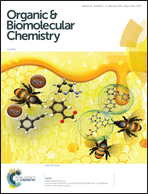H-Transfer reactions of internal alkenes with tertiary amines as H-donors on carbon supported noble metals†
Abstract
A hydride transfer reaction with tertiary amines was observed in the presence of noble metals on a carbon support. Hydride transfer had been documented previously in terms of activated allyl-type carbon–carbon double bonds containing carbonyl derivatives in the presence of triethyl amine (conjugate reduction). The proposed mechanism is a hydride transfer reaction in which the metal serves as the reaction partner of the hydrido-metal iminium adduct formation. The saturation of a non-activated internal double bond containing compound, such as methyl oleate and trans-5-decene as substrates, was observed for the first time in this work. The pre-reduced catalyst samples showed high activity; in the presence of Pd/C, Pt/C and Rh/C partial to complete conversion was detected at 140 °C in a p-xylene solvent without molecular hydrogen. Higher molecular weight byproducts of the amines were formed, while in the case of the substrates negligible amounts of unreacted but double bond migrated species were present. There is a possibility of usage of alkyl amines other than triethylamine; thus use of tributyl-, tripentyl-, trihexylamine and N,N-diisopropylethylamine, as well as cyclic 1-ethylpyrrolidine and 1-ethylpiperidine, was investigated. Cyclic amines and diisopropyl derivatives as H sources produced the highest conversion, while amines with longer alkyl chains showed minor activity. As a clear indication of H-donation, the formation of unsaturated amine species such as 1-ethyl-pyrrole and pyridine was observed.



 Please wait while we load your content...
Please wait while we load your content...